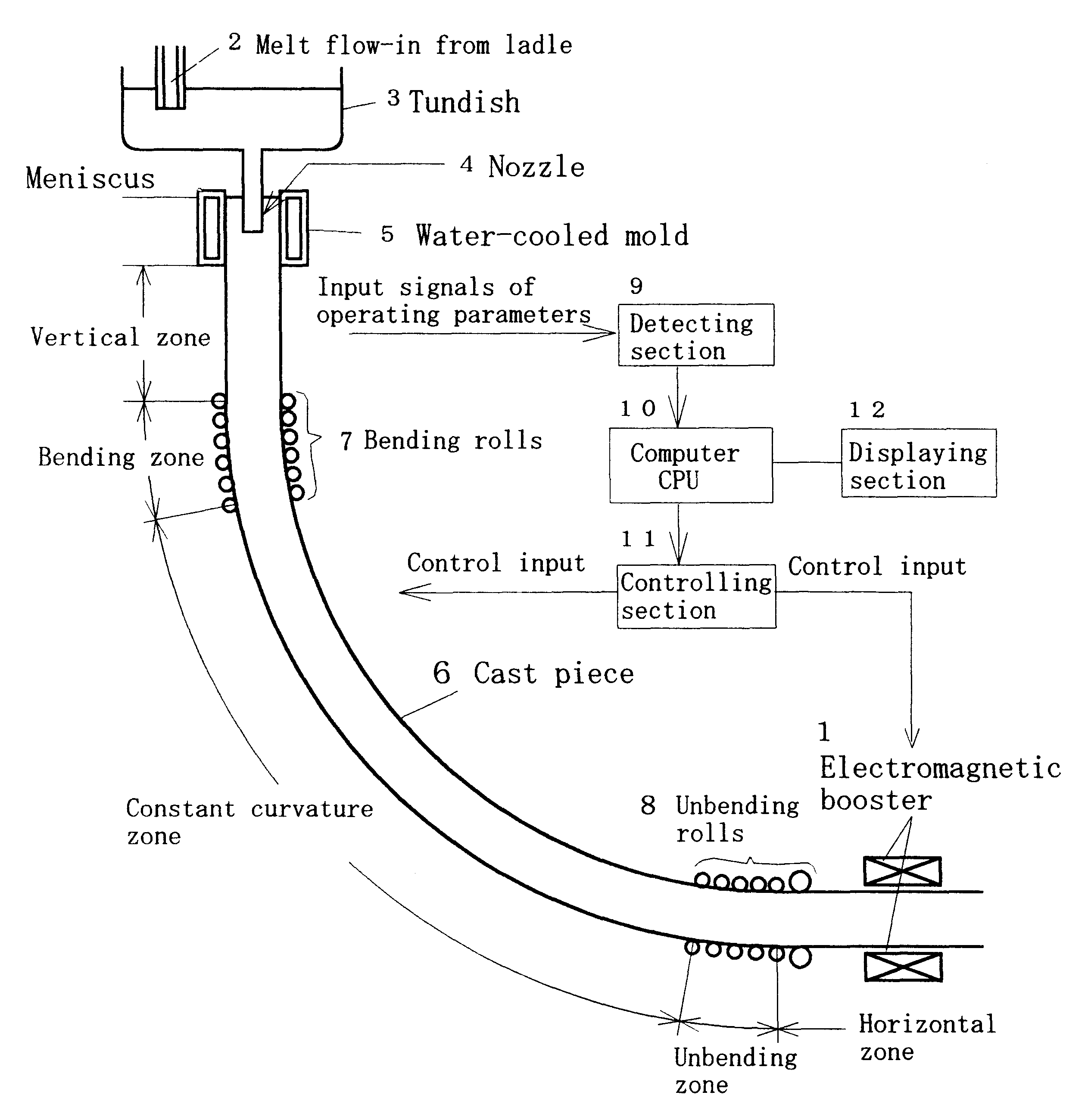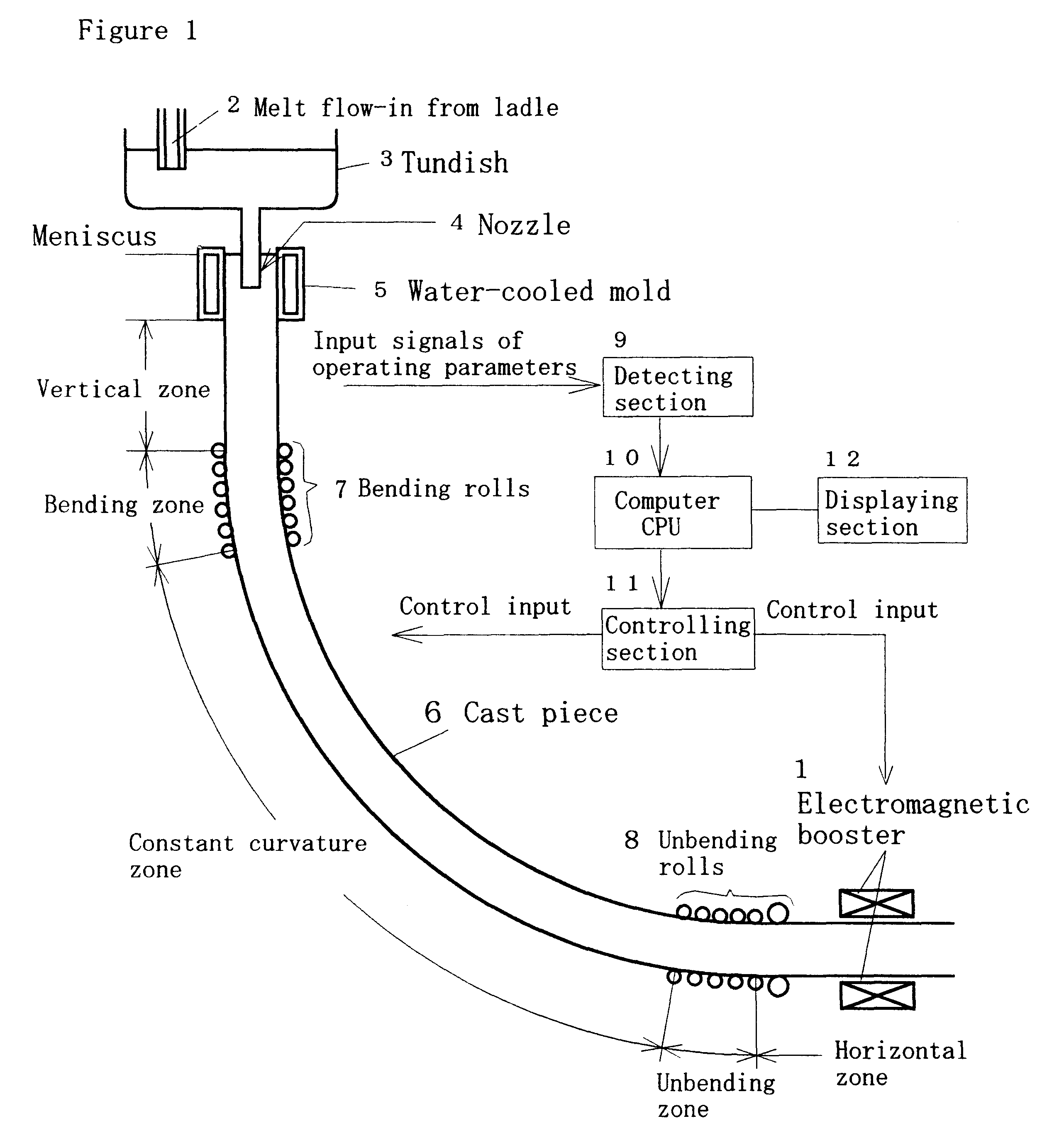Method and apparatus for continuous casting
- Summary
- Abstract
- Description
- Claims
- Application Information
AI Technical Summary
Benefits of technology
Problems solved by technology
Method used
Image
Examples
specific example 1
om and Billet
The specific example applied to steel bloom or billet is shown in FIG. 58. With respect to machine profile, vertical-bending type or bending type is most widely used as schematically shown in FIG. 1. FIG. 58 shows the case that the electromagnetic booster is located in the upstream vicinity of the final solidification zone (crater end) at the horizontal zone of cast piece. FIGS. 58(a) is the cross-sectional plan and (b) is AA cross-sectional plan in longitudinal direction. The arrow in the diagram denotes the casting direction. The view from the top, BB cross-section, is shown in FIG. 59.
Symbol 6 in the figure denotes the cast piece and Symbol 102 denotes the electrode located at both sides of the cast piece that contacts with the side surface. The electrode is fixed to the frame 107 (details not shown) with spring 106 and slides against the moving cast piece. The plural number of electrodes is arranged over the Lorentz force zone as shown in FIG. 58(b). Each electrode ...
specific example 2
Case Where the Distance Between Coils is Shortened.
Considering this point, the width of the coil was expanded and the distance between the coils was shortened to obtain a stronger magnetic field compared to Specific example 1. The cross-sectional view is shown in FIG. 63(a). For this, the distance between the coils was shortened by setting up spaces in the upper frame 117 and the lower frame 118 to house the roll units. If the distance between the coils is too short, the coils collide with or approach too close to the cast piece at the position where the coils cross the cast piece. In such a case, horse-saddle type coil may be used to secure a necessary space at both ends of the coil as shown in FIG. 63(b).
This example is basically applied to the case where the driving units of rolls are not required by properly adjusting the balance of the Lorentz force and the drawing resistant force due to soft-reduction (Function II of the above-mentioned). [If the roll drive is inevitably neede...
specific example 3
b
The specific example applied to a wide slab is shown in FIG. 64, where both Lorentz force and small amount of soft-reduction are given. Because the reduction rolls are long and slender and easy to bend due to reduction load and thermal stress, split rolls are used. The reduction force is given by oil-hydraulic cylinder. The reduction is done by upper roll in general and the hydraulic cylinder 127 is attached to each bearing unit. The cylinder stroke may be short as already mentioned. If more margin is necessary, the unit of specific example 2 can be used. As to the roll, one piece of roll may be used whose diameter is squeezed at bearing units or may be divided into split rolls and each of them supported independently at the bearing units. Also, it is desirable to prevent the plastic deformation at the cross-section corners by attaching roundness at both sides of the end rolls. Roll-drive is done by lower rolls in general. Other mechanisms such as electrode are same as those of spe...
PUM
| Property | Measurement | Unit |
|---|---|---|
| Fraction | aaaaa | aaaaa |
| Fraction | aaaaa | aaaaa |
| Fraction | aaaaa | aaaaa |
Abstract
Description
Claims
Application Information
 Login to View More
Login to View More - R&D
- Intellectual Property
- Life Sciences
- Materials
- Tech Scout
- Unparalleled Data Quality
- Higher Quality Content
- 60% Fewer Hallucinations
Browse by: Latest US Patents, China's latest patents, Technical Efficacy Thesaurus, Application Domain, Technology Topic, Popular Technical Reports.
© 2025 PatSnap. All rights reserved.Legal|Privacy policy|Modern Slavery Act Transparency Statement|Sitemap|About US| Contact US: help@patsnap.com



